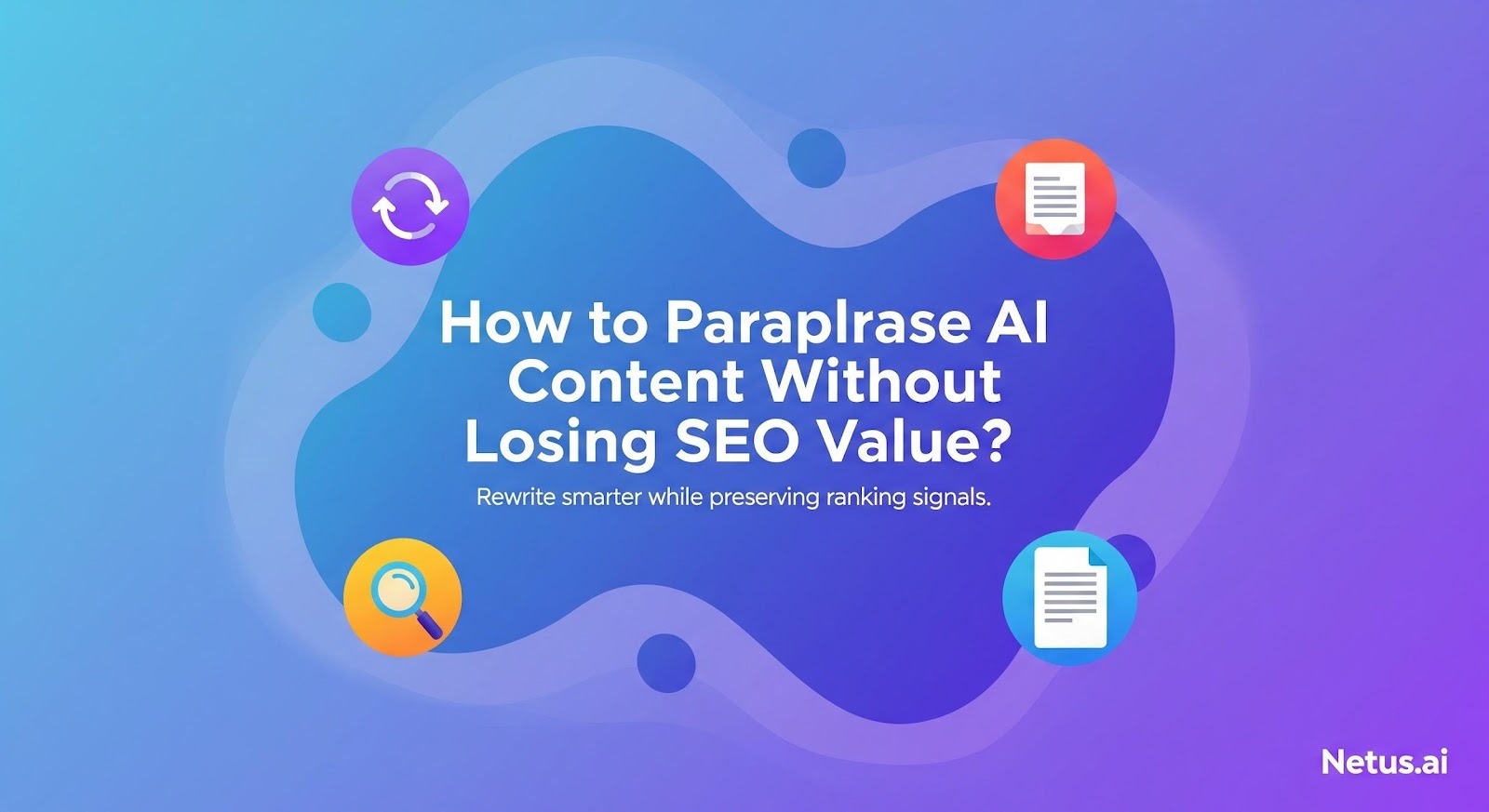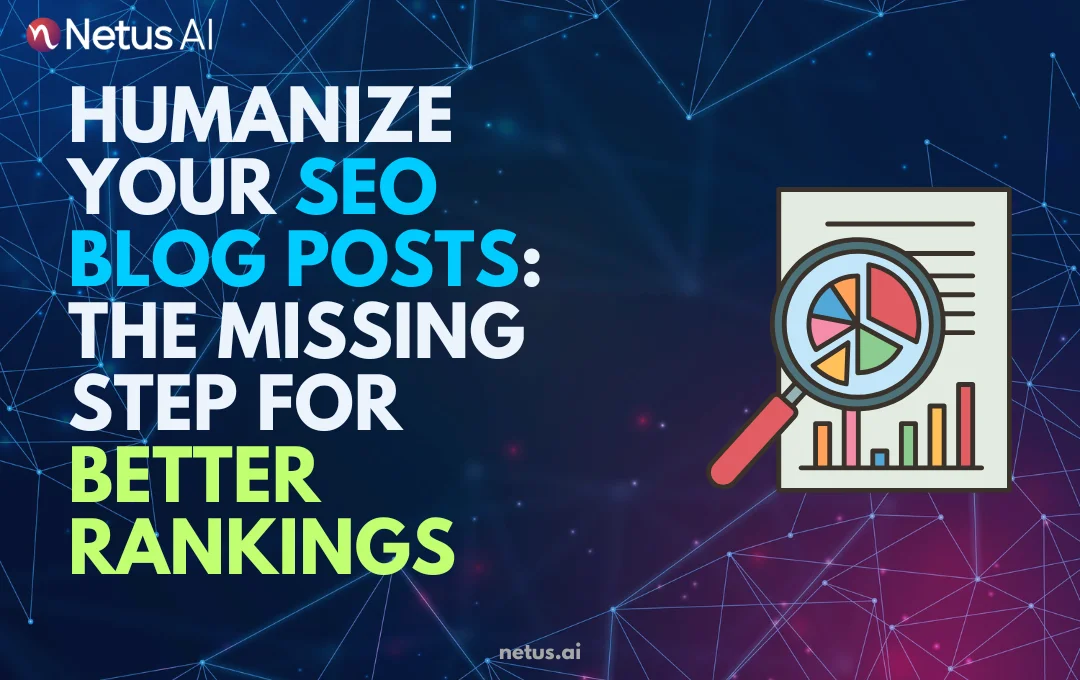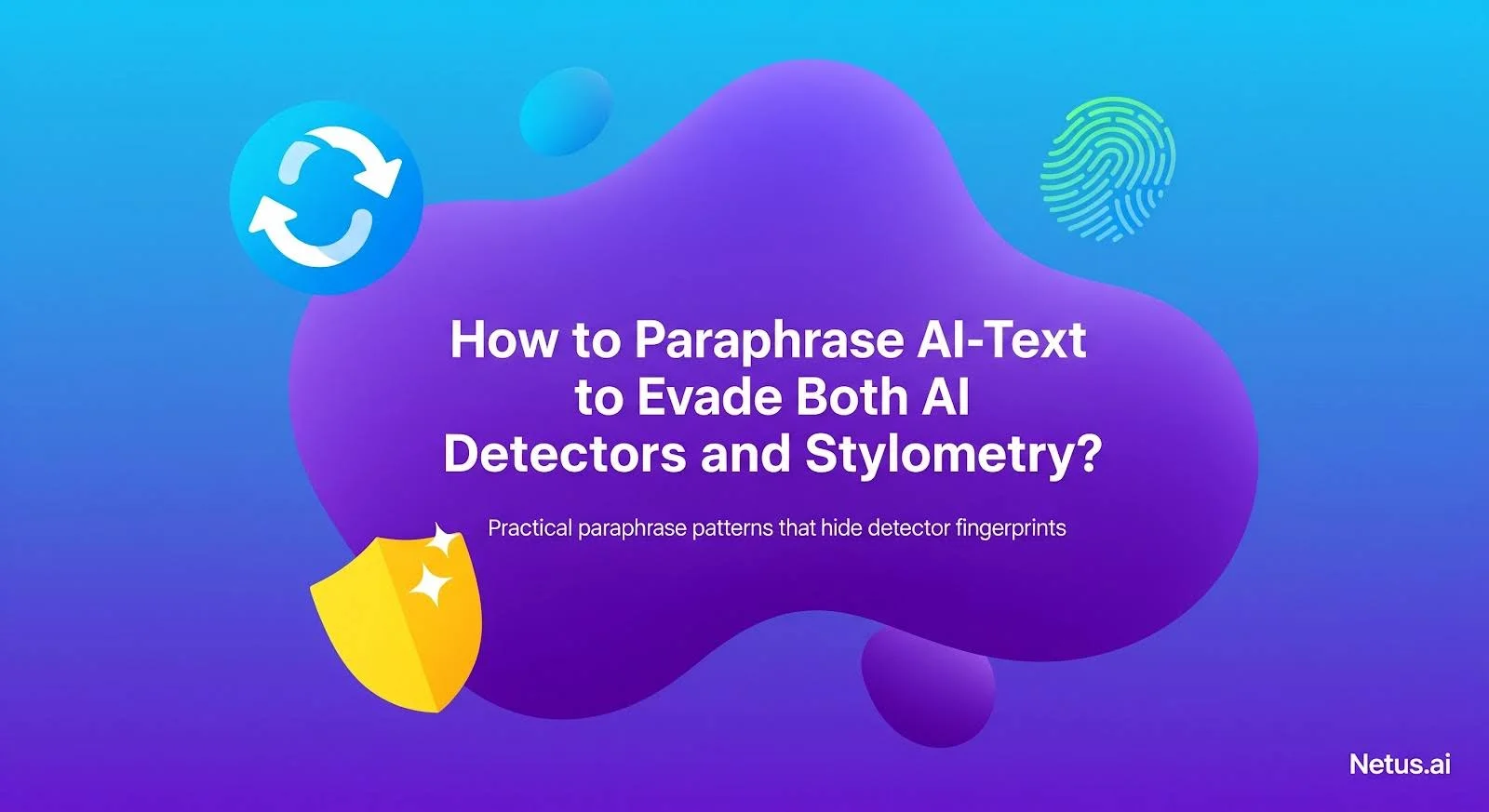AI writing tools efficiently generate large drafts, overcoming writer’s block. However, this raw AI content is not ready for publication.
Posting it risks SEO value due to Google’s detection, readers’ preference for authenticity and content detectors. The key is to master paraphrasing the AI output to ensure authenticity while preserving its SEO benefits.
The double-edged sword: Why raw AI content needs surgery?

AI tools generate text at an astonishing pace. They synthesize information, follow instructions (mostly) and produce coherent drafts.
That’s the gleaming edge of the sword. The other edge? It often feels generated. It can be verbose, structurally repetitive, overly formal or jarringly casual at the wrong moments and sometimes drifts into factual shallows.
More critically, Google’s guidelines, especially their emphasis on Experience, Expertise, Authoritativeness and Trustworthiness (EEAT), aren’t just buzzwords.
They’re a framework for judging content value. While Google states they reward good content regardless of origin, content that clearly lacks human insight, depth or originality, hallmarks of much unedited AI text, is unlikely to satisfy EEAT.
It risks being flagged as thin, unhelpful or simply, robotic. Readers sense it too. That slightly “off” tone erodes trust.
They click away, sending negative signals (high bounce rates, low dwell time) that search engines absolutely notice. Paraphrasing, done right, is your scalpel, removing the AI fingerprints while preserving the underlying informational structure and SEO potential.
Cracking the code: What makes AI scream "I was generated!"?
So, how do detectors spot AI and what triggers Google’s suspicion? It’s rarely about single words. It’s about patterns, the digital equivalent of tells at a poker table:
- Stylometry – The AI “fingerprint”: AI writing has a mechanical rhythm and predictable style (complex/simple sentences, common transitions, odd vocabulary, flat tone), making it easily identifiable.
- The hallmarks of hallucination (or superficiality): While improving, AI can still confidently state inaccuracies (“hallucinate”) or skate over complex nuances. It might present information generically without the insightful connections, critical analysis or unique perspective a true expert provides. This lack of depth is a major EEAT red flag for Google.
- Structural repetition: AI loves templates. Paragraphs might follow identical syntactic structures. Introductions and conclusions can feel formulaic. Arguments might be presented in a predictable, point-by-point manner without organic flow.
- Detector tool signatures: Tools like ZeroGPT and others analyze these stylistic patterns, perplexity (how predictable word choice is) and burstiness (variation in sentence length/complexity). Unedited AI content often scores highly on these detectors, raising red flags for publishers, educators and potentially, search quality evaluators.
The SEO graveyard of lazy rewrites
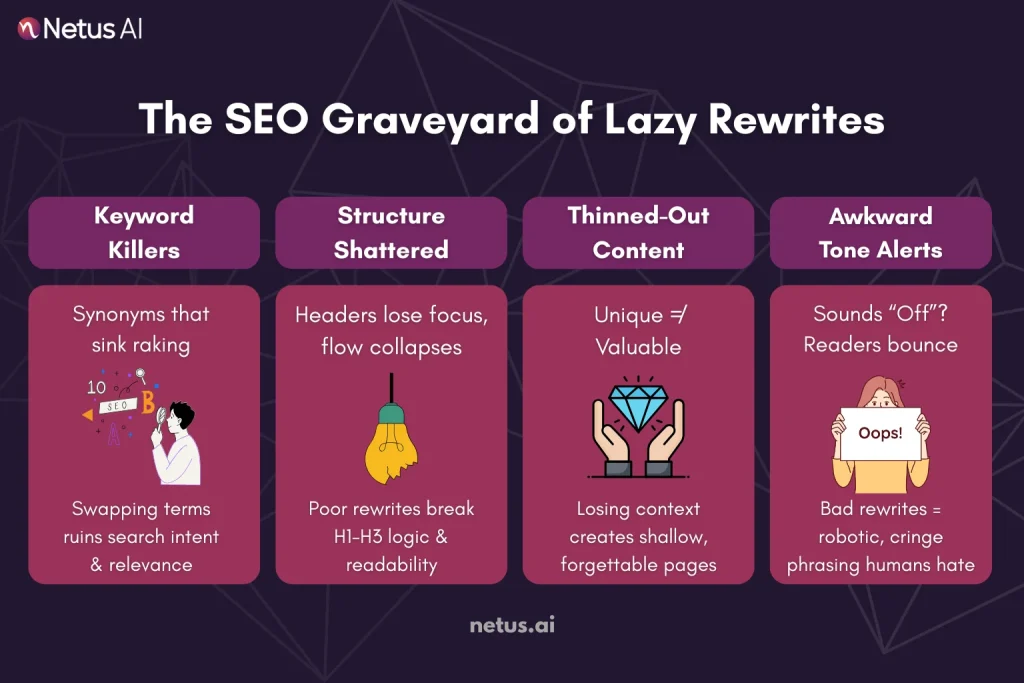
Recognizing the need to change AI content, many turn to quick fixes. Running text through a basic synonym-swapping tool or a superficial manual rewrite is a recipe for SEO disaster.
- Keyword carnage: Hasty paraphrasing with basic tools often replaces crucial keywords (like “sustainable garden design” with “eco-friendly yard planning”) or removes them, damaging search intent, volume and topical relevance (LSI keywords and related entities are lost).
- Structural collapse: SEO relies on content architecture, including headings (H1-H6) and semantic structure. Poor paraphrasing often ruins this, making the text awkward, losing keyword focus in headings and disrupting the logical flow, confusing both users and search engines.
- Thinning the broth: In the rush to “make it different,” crucial context, supporting examples or subtle nuances from the original AI draft get stripped away. What remains might be technically unique but lacks substance and depth. This directly feeds into Google’s criteria for “thin content”, pages that offer little original value or comprehensive coverage.
- The uncanny valley of tone: Replacing words without context creates unnatural, awkward phrasing, hurting user experience and causing engagement to drop, which negatively impacts SEO.
Beyond synonyms: The anatomy of smart AI paraphrasing
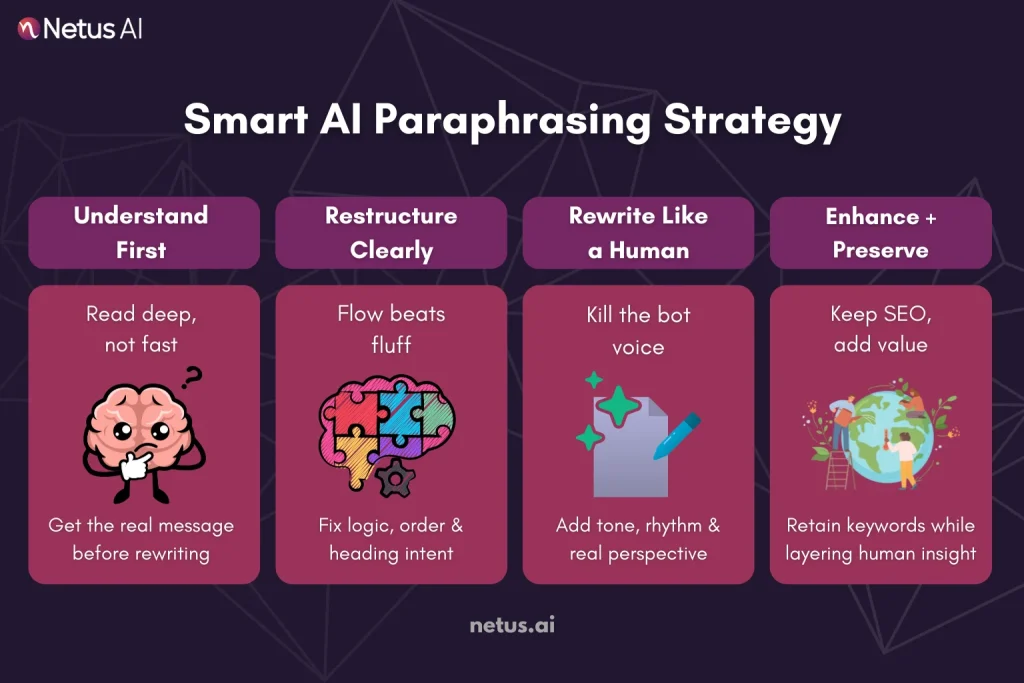
Effective paraphrasing for SEO isn’t word games; it’s transformation with intent. It requires a strategic blend of human editorial skill and, often, intelligent tool assistance. Here’s the process:
- Deep comprehension first: Don’t just read; understand the AI-generated draft. What are the core arguments? Key facts? Target keywords? Intended audience? What’s valuable and what’s fluff or inaccurate? This understanding is your bedrock.
- Restructure with purpose: Focus on improving logical flow, combining repetitive points, breaking down complex paragraphs, and refining the heading structure and transitions for better readability and SEO.
- Rewrite for Voice & Nuance:
- Vary Sentence Structure: Mix lengths, change start points.
- Ditch Robotic Diction: Use clear language; swap formal transitions for natural ones.
- Add Human Elements: Include personal anecdotes, quotes, examples, analogies, opinions, and rhetorical questions.
- Sharpen the Focus: Eliminate fluff, deepen explanations, add concrete details.
- Keyword & entity stewardship: Focus on target keywords and semantic entities. Integrate keywords naturally, avoiding stuffing. Preserve semantic links and key concepts/definitions, only using synonyms when they improve readability and don’t harm relevance.
- Enhance value: Go beyond just rewriting. Can you add a unique insight, a counter-argument, a more recent statistic, a practical tip sheet or a relevant case study? This extra layer of genuine value is pure EEAT gold.
Content starts at generation: NetusAI’s SEO article writer and content generator
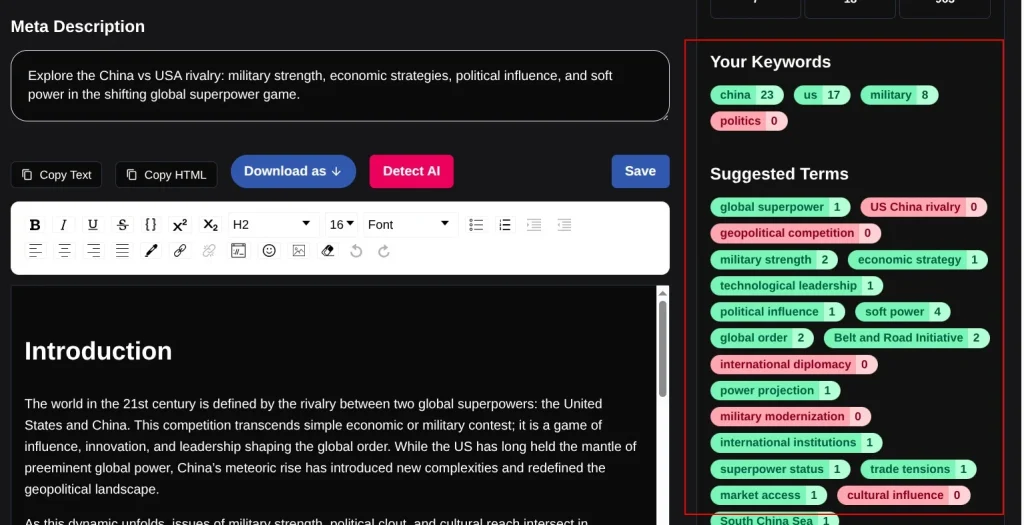
Avoiding stylometry and detection issues shouldn’t begin after content is written, it should start with the writing itself. That’s where NetusAI steps in.
Unlike generic AI tools that churn out robotic, easily flagged paragraphs, The NetusAI SEO Article Generator is designed to help you create full-length blog posts that are already optimized for clarity, tone and search intent. Unlike generic tools, it goes beyond simple drafting. It:
- Lets you input headlines and targeted SEO keywords
- Supports long-form templates for full blogs
- Auto-generates a structure with Title → Outline → Content
- Works in multiple languages for global teams
And most importantly: it ties directly into the Netus AI Bypasser + Detector system, meaning your output isn’t just readable, it’s already tuned to avoid detection.
You can generate, review and rewrite all in one interface without needing third-party tools to patch the gaps. It’s built for marketers, freelancers and bloggers who want their AI content to actually pass as human-written.
Content Generator
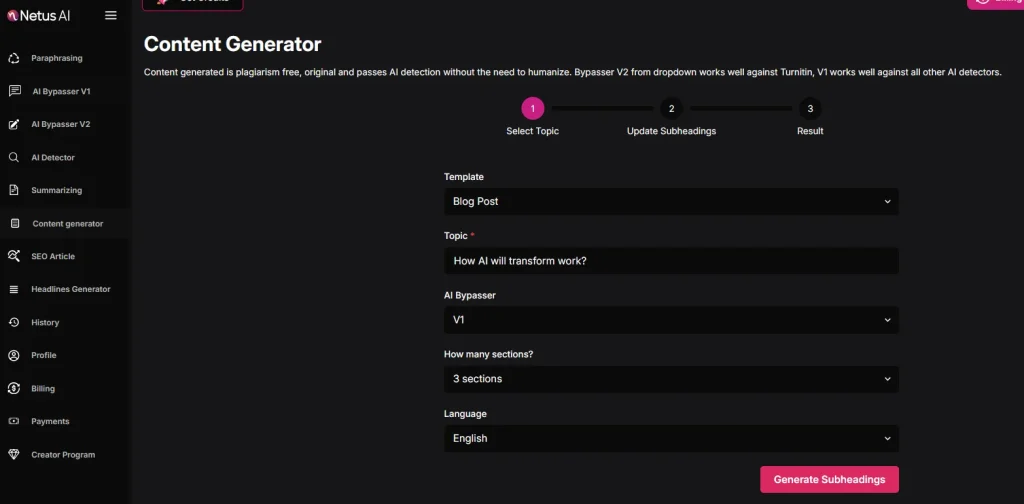
NetusAI also offers a Content Generator. Following the simple steps as shown on the user-friendly NetusAI page, Plagiarism Free Content will be generated from the beginning. The result generated can be downloaded and copied directly as well. Users can easily view their results as they will be stored in the history tab.
So whether you’re starting from scratch or turning an idea into a full SEO article, NetusAI saves you time and rewrites, without sacrificing trust or quality.
Final thoughts
Paraphrasing AI content isn’t about masking machine writing, it’s about transforming it into valuable, human-readable content that serves your audience and stays SEO-safe. When done correctly, paraphrasing helps retain the essence of your message while improving originality, clarity and tone.
Whether you’re optimizing for Google’s algorithms or trying to pass advanced AI detectors, the right approach and the right tools make all the difference.
That’s why the smart play is hybrid creation, with NetusAI, you can:
- Write with structure using the SEO Article Writer
- Plagiarism free Content Generator
- Detect and fix red flags with the AI Bypasser
FAQs
Raw AI content often lacks originality, flow, and EEAT. Paraphrasing humanizes it, maintaining structure, intent, and SEO relevance.
It can, if done poorly. But SEO-aware paraphrasing, like what NetusAI offers, retains key phrases and entities while rewriting sentences around them naturally.
Yes, if it’s low-effort or follows predictable AI patterns. Google’s systems look at style, repetition and content depth, not just whether it’s copied or unique.
NetusAI doesn’t just spin text, it rewrites with structure, tone and semantic clarity. It also includes real-time AI detection feedback and bypassers designed to fool even advanced detectors without hurting SEO.
Start with flagged or robotic sections. NetusAI lets you test, tweak and retest blocks of content, making it easy to fix only what needs humanizing.

